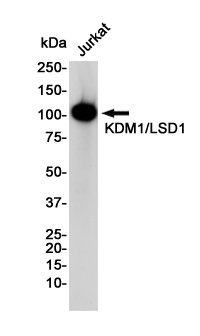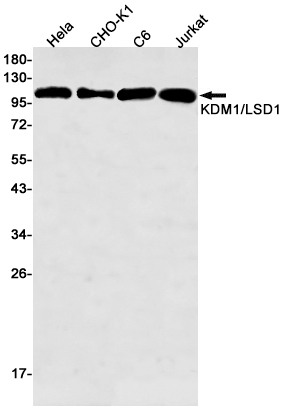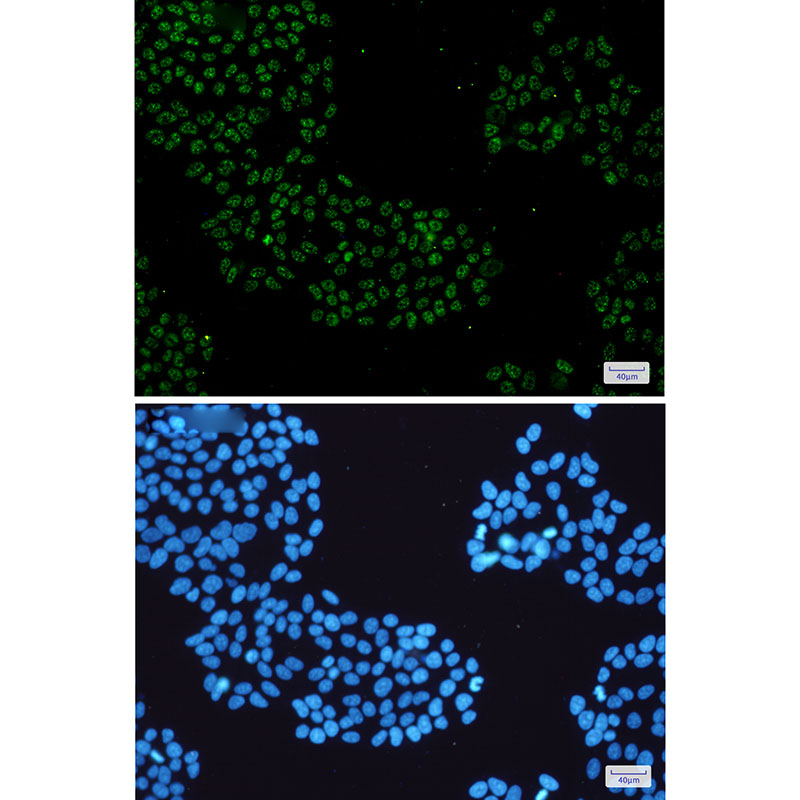


| WB | 1/500-1/1000 | Human,Rat,Hamster |
| IF | 咨询技术 | Human,Rat,Hamster |
| IHC | 咨询技术 | Human,Rat,Hamster |
| ICC | 1/50-1/200 | Human,Rat,Hamster |
| FCM | 咨询技术 | Human,Rat,Hamster |
| Elisa | 咨询技术 | Human,Rat,Hamster |
| Aliases | KDM1A; AOF2; KDM1; KIAA0601; LSD1; Lysine-specific histone demethylase 1A; BRAF35-HDAC complex protein BHC110; Flavin-containing amine oxidase domain-containing protein 2 |
| Entrez GeneID | 23028 |
| WB Predicted band size | Calculated MW: 93 kDa; Observed MW: 110 kDa |
| Host/Isotype | Rabbit IgG |
| Antibody Type | Primary antibody |
| Storage | Store at 4°C short term. Aliquot and store at -20°C long term. Avoid freeze/thaw cycles. |
| Species Reactivity | Human,Rat,Hamster |
| Immunogen | A synthetic peptide of human KDM1/LSD1 |
| Formulation | Purified antibody in TBS with 0.05% sodium azide,0.05%BSA and 50% glycerol. |
+ +
以下是3篇关于KDM1A抗体的代表性文献,简要概括内容:
---
1. **文献名称**: *LSD1 is a subunit of the NuRD complex and targets the metastasis programs in breast cancer*
**作者**: Nicholson, T.B. and Chen, T.
**摘要**: 研究通过免疫组化和Western blot使用KDM1A抗体,揭示了KDM1A在乳腺癌转移中的调控作用,发现其与NuRD复合物结合并促进癌细胞侵袭性。
---
2. **文献名称**: *Lysine-specific demethylase 1 is strongly expressed in poorly differentiated neuroblastoma: implications for therapy*
**作者**: Schulte, J.H. et al.
**摘要**: 该研究利用KDM1A抗体检测神经母细胞瘤中KDM1A的高表达,表明其表达水平与肿瘤分化程度和患者预后相关,为靶向治疗提供依据。
---
3. **文献名称**: *Structural basis for LSD1-CoREST selectivity in histone H3 recognition*
**作者**: Shi, Y. et al.
**摘要**: 通过X射线晶体学和特异性KDM1A抗体验证,阐明了KDM1A与CoREST复合物的结合机制及其对组蛋白H3的去甲基化活性,为开发选择性抑制剂奠定基础。
---
以上文献均以KDM1A抗体作为关键实验工具,涵盖癌症机制、结构生物学及临床相关性研究。如需更多文献或具体DOI号,可进一步补充说明。
KDM1A (lysine-specific histone demethylase 1A), also known as LSD1. is a flavin-dependent enzyme that catalyzes the demethylation of histone H3 lysine 4 (H3K4me1/2) and lysine 9 (H3K9me2), playing a critical role in epigenetic regulation of gene expression. As a member of the amine oxidase superfamily, it regulates chromatin remodeling, stem cell pluripotency, and cellular differentiation by modulating histone methylation dynamics. Dysregulation of KDM1A is implicated in cancer, neurological disorders, and developmental diseases, making it a key therapeutic target.
KDM1A antibodies are essential tools for studying its expression, localization, and function in biological systems. These antibodies enable detection of KDM1A in techniques like Western blotting, immunohistochemistry (IHC), immunofluorescence (IF), and chromatin immunoprecipitation (ChIP). High-quality KDM1A antibodies exhibit specificity validated via knockout controls or peptide-blocking assays, ensuring accurate identification in complex samples.
Research applications include investigating KDM1A’s role in oncogenesis, where it often promotes tumor growth and metastasis by repressing tumor suppressor genes. Additionally, KDM1A antibodies aid in exploring its interaction with co-factors like CoREST or SNAG-domain proteins, which modulate its enzymatic activity. Recent studies also focus on developing KDM1A inhibitors, highlighting the antibody’s utility in preclinical drug evaluation. Overall, KDM1A antibodies are indispensable for advancing epigenetic research and therapeutic discovery.
×